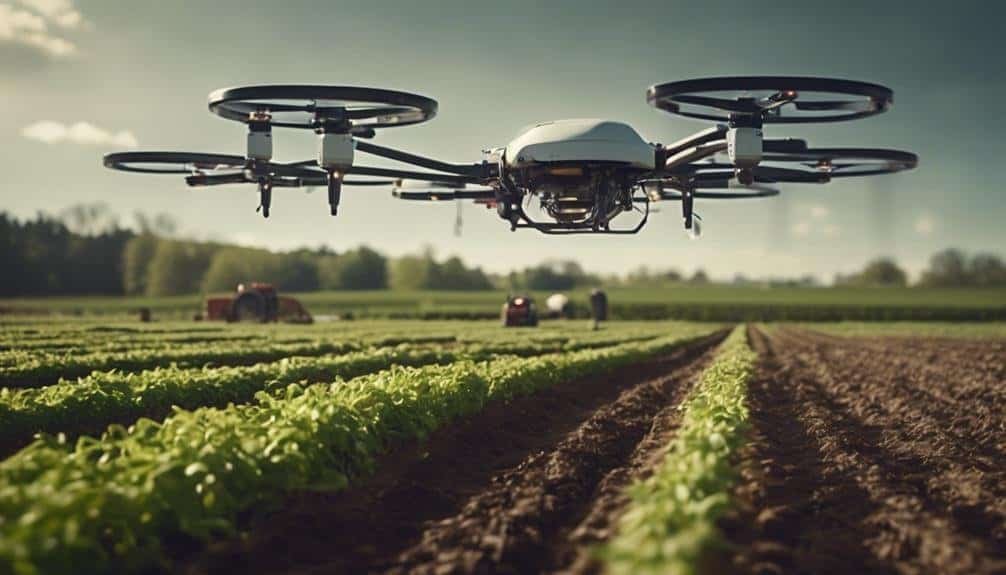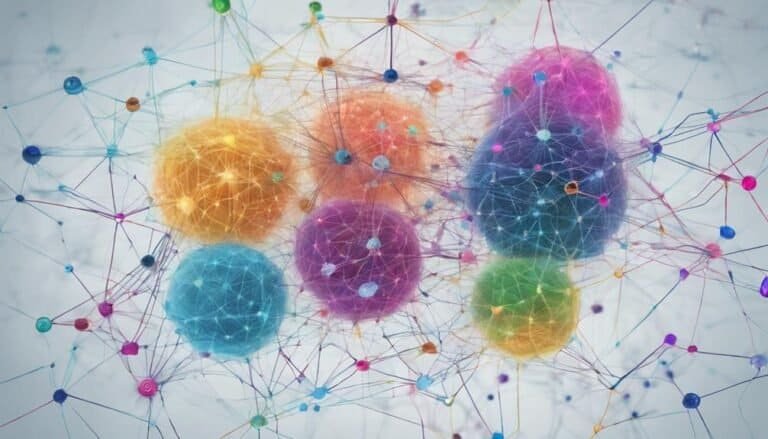AI in Agriculture: Smart Farming Technologies
The integration of AI in agriculture has revolutionized the sector, paving the way for smart farming technologies that enhance efficiency and productivity. From AI-powered crop monitoring to precision agriculture techniques, these advancements are reshaping traditional farming practices.
Automated irrigation systems, drone technology, and data analytics play crucial roles in modern agriculture, offering insights and solutions that were once unimaginable. But what do these advancements mean for the future of farming, and how will AI continue to transform the agricultural landscape?
Key Takeaways
- AI-powered technologies revolutionize crop monitoring and decision-making.
- Data-driven crop management enhances sustainability and productivity.
- Sensor technology integration allows for precise farming practices.
- Advanced applications like automated irrigation optimize resource usage.
AI-Powered Crop Monitoring
Utilizing advanced artificial intelligence algorithms, AI-powered crop monitoring systems have revolutionized the agricultural industry by providing real-time monitoring and predictive analytics on crop health and growth patterns. These systems leverage cutting-edge technology to collect vast amounts of data from various sources such as drones, satellites, and IoT devices.
The ability to analyze this data in real-time enables farmers to make informed decisions promptly, leading to increased efficiency and higher crop yields. By continuously monitoring factors like soil moisture levels, temperature variations, and pest infestations, AI-powered systems can predict potential issues before they escalate, allowing for proactive interventions.
Moreover, these systems offer personalized recommendations based on the analyzed data, optimizing resource allocation and reducing wastage. The integration of predictive analytics helps farmers adapt their strategies according to dynamic environmental conditions, ultimately enhancing productivity and sustainability in agriculture.
Precision Agriculture Techniques
Precision agriculture techniques are revolutionizing the way farmers manage their crops.
By emphasizing data-driven decision-making and the integration of sensor technologies, farmers can optimize their crop management practices.
This innovative approach leverages real-time data and advanced analytics to improve yields and reduce resource wastage.
The result is agricultural practices that are efficient, sustainable, and tailored to the specific needs of each crop.
Data-Driven Crop Management
Implementing advanced data analytics techniques has revolutionized crop management practices in modern agriculture. By utilizing data-driven approaches, farmers can now make more informed decisions regarding soil health and climate resilience.
Through the analysis of soil data, such as nutrient levels and moisture content, farmers can optimize fertilization and irrigation practices, leading to improved soil health and increased crop yields. Moreover, with the help of climate data and predictive analytics, farmers can enhance their resilience to changing weather patterns and mitigate the impact of extreme events.
Data-driven crop management not only maximizes agricultural productivity but also promotes sustainability by minimizing resource wastage and environmental impact.
Sensor Technology Integration
The integration of sensor technology in agriculture has revolutionized precision farming practices. It allows for real-time monitoring and data-driven decision-making to optimize crop management strategies. Sensors play a crucial role in assessing soil health by measuring key indicators such as moisture levels, nutrient content, and pH levels. This data enables farmers to make informed decisions regarding irrigation, fertilization, and soil amendments, leading to improved crop yields and resource efficiency.
Moreover, sensor technology aids in enhancing climate resilience by providing insights into weather patterns. This allows farmers to anticipate and mitigate potential risks such as droughts or excessive rainfall. By leveraging sensor data, farmers can implement proactive measures to adapt to changing environmental conditions and ensure sustainable agricultural practices.
Automated Irrigation Systems
In the realm of modern agriculture, the integration of automated irrigation systems has revolutionized the efficiency and sustainability of crop cultivation practices. These systems utilize advanced technologies to monitor and manage irrigation processes based on data-driven insights, leading to optimized water usage and improved crop health.
By utilizing sensors to continuously track soil moisture levels, automated irrigation systems ensure that crops receive the precise amount of water they need, minimizing water wastage and reducing the risk of overwatering or underwatering. This precision not only conserves water resources but also promotes better crop health by maintaining optimal moisture levels in the soil, which is crucial for plant growth and productivity.
Automated irrigation systems play a vital role in enhancing agricultural practices by providing farmers with real-time information and control over irrigation activities, contributing to increased yields, cost savings, and environmental sustainability in the farming sector.
Drone Technology in Farming
Utilizing cutting-edge drone technology, agriculture is experiencing a transformative shift towards more efficient and precise farming practices. Drones equipped with various sensors enable farmers to gather real-time data through remote sensing, revolutionizing how they monitor and manage their fields. These drones can capture high-resolution images, multispectral data, and thermal readings, providing valuable insights into crop health, irrigation needs, and pest infestations.
One of the key applications of drone technology in farming is field mapping. Drones can swiftly survey vast expanses of land and generate detailed 3D maps, helping farmers to identify variations in soil composition, moisture levels, and crop health across different areas of their fields. This data-driven approach allows for targeted interventions, such as optimized irrigation strategies and precise application of fertilizers or pesticides, ultimately leading to increased yields and cost savings.
Data Analytics for Yield Optimization
Implementing data analytics for yield optimization in agriculture allows for a meticulous examination of yield data to identify patterns and trends essential for enhancing crop production efficiency.
By leveraging advanced analytics tools, farmers can make data-driven decisions to optimize planting practices, irrigation schedules, and nutrient management strategies for achieving maximum yield output.
This innovative approach not only boosts productivity but also aids in sustainable farming practices by minimizing resource wastage and maximizing the utilization of available land.
Yield Data Analysis
Leveraging advanced data analytics techniques is pivotal in optimizing agricultural yields through comprehensive yield data analysis. By conducting statistical analysis on crop yield data, farmers can gain valuable insights into factors influencing production. Utilizing AI algorithms, vast amounts of data can be processed to identify patterns, correlations, and anomalies that impact yield levels.
| Benefits of Yield Data Analysis | Description |
|---|---|
| Enhanced Decision-Making | Data-driven insights enable informed choices for crop management. |
| Precision Agriculture | Tailoring farming practices based on analyzed data leads to optimized yields. |
| Risk Mitigation | Identifying potential risks early on allows for proactive measures to safeguard crop yield. |
Optimal Crop Production
Analyzing and interpreting data for optimal crop production is a fundamental aspect of modern agriculture, enabling farmers to make data-driven decisions that enhance yield levels. Through advanced data analytics, farmers can optimize crop production by considering factors such as soil quality and weather forecasting.
By analyzing soil quality data, farmers can make informed decisions regarding the types and quantities of fertilizers needed, leading to improved crop health and yield. Additionally, leveraging weather forecasting data allows farmers to plan planting and harvesting activities efficiently, minimizing losses due to adverse weather conditions.
Ultimately, the integration of data analytics for yield optimization empowers farmers to maximize productivity while promoting sustainability in agriculture practices.
AI-Based Pest and Disease Management
Utilizing AI technology for pest and disease management in agriculture presents a cutting-edge solution to enhance crop health and productivity.
- Disease Detection: AI systems can analyze vast amounts of data from various sources such as satellite imagery, weather conditions, and plant characteristics to detect diseases at early stages. This early detection enables farmers to take proactive measures to prevent the spread of diseases and minimize crop losses.
- Pest Control: AI algorithms can identify patterns in pest behavior and predict potential infestations. By integrating data from sensors, drones, and other monitoring devices, AI can help farmers target specific areas for pest control measures, reducing the need for broad pesticide application and minimizing environmental impact.
- Precision Farming: AI-powered tools enable precision application of pesticides and fertilizers, reducing waste and optimizing resource utilization. By accurately targeting areas in need of treatment, farmers can achieve higher crop yields while minimizing costs and environmental harm.
Future Trends in Smart Farming
The evolution of smart farming is poised to revolutionize agricultural practices through the integration of advanced technology and data-driven strategies. As we look towards the future of smart farming, two key trends emerge: a focus on climate resilience and the adoption of sustainability practices.
Future Trends in Smart Farming
| Future Trends | Description | Impact |
|---|---|---|
| Climate resilience | Implementing AI and IoT for real-time climate data | Enhancing crop management in changing environmental conditions |
| Sustainability practices | Using precision agriculture for resource optimization | Reducing environmental impact and improving efficiency |
| Automation | Integration of robotics and drones for farm tasks | Streamlining operations and increasing productivity |
Embracing climate resilience involves utilizing AI and IoT technologies to gather real-time climate data. This enables farmers to make informed decisions to manage crops effectively in the face of changing environmental conditions. Sustainability practices, on the other hand, focus on optimizing resources through precision agriculture, ultimately reducing the environmental footprint of farming operations while enhancing overall efficiency. Automation through the integration of robotics and drones further streamlines farm tasks, boosting productivity and paving the way for a more sustainable and climate-resilient agriculture sector.
Conclusion
In conclusion, the integration of AI technologies in agriculture has revolutionized the industry by enhancing crop monitoring, implementing precision agriculture techniques, optimizing irrigation systems, utilizing drone technology, and improving pest and disease management.
The future trends in smart farming are promising, with advancements in data analytics and AI-driven solutions set to further increase efficiency and productivity in farming practices.
The impact of AI in agriculture is nothing short of transformative, paving the way for a more sustainable and technologically advanced future.







